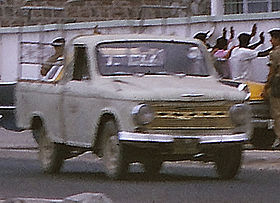
A pickup truck or pickup is a light-duty truck having an enclosed cab and an open cargo area with low sides and tailgate. In Australia and New Zealand, both pickups and coupé utilities are called utes, short for utility vehicle. In South Africa, people of all language groups use the term bakkie, a diminutive of bak, Afrikaans for "bowl" or "container".

The Toyota 4Runner is a compact, later mid-size sport utility vehicle produced by the Japanese manufacturer Toyota and sold throughout the world from 1984 to present. In Japan, it is known as the Toyota Hilux Surf which was withdrawn from the market in 2009. The original 4Runner was a compact SUV and little more than a Toyota pickup truck with a fiberglass shell over the bed, but the model has since undergone significant independent development into a cross between a compact and a mid-size SUV. All 4Runners have been built in Japan at Toyota's plant in Tahara, Aichi, or at the Hino Motors plant in Hamura.
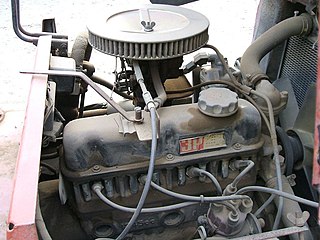
The Toyota P family is an overhead valve inline-four engine produced from October 1959 through 1994. Originally fitted to the Corona passenger car, it was soon relegated to commercial use vehicles and for its latter two decades it mostly powered various forklifts.

The Toyota Motor Corporation G-family engine is a family of straight-6 piston engines produced from 1979 to 2006. It is notable in that only a single displacement, 2.0 L (1,988 cc), was produced in this series. All were belt-driven OHC non-interference engines, with multivalve DOHC and even variable valve timing added later. The 1G-GEU was Toyota's first four-valve twincam engine. A prototype version of the 1G-GEU called the LASREα–X, featuring twin-turbos, variable valve timing and intake as well as variable displacement, was fitted to the Toyota FX-1 show car at the 1983 Tokyo Motor Show. It showcased a number of technologies which were later to become commonplace.
The Toyota Stout was a light truck produced by the Japanese automaker Toyota from 1954 through 1989. The Stout shared its platform with the Toyota Dyna until 1968, when the Dyna was given its own platform, called the Toyota "U". In Japan, it was sold at Toyota Japanese dealerships called Toyopet Store.

The Toyota Hilux is a series of pickup trucks produced and marketed by the Japanese automobile manufacturer Toyota. The majority of these vehicles are sold as pickup truck or cab chassis variants, although they could be configured in a variety of body styles. The pickup truck was sold with the HiLux name in most markets, but in North America, the Hilux name was retired in 1976 in favor of Truck, Pickup Truck, or Compact Truck. In North America, the popular option package, the SR5, was colloquially used as a model name for the truck, even though the option package was also used on other Toyota models, like the 1972 to 1979 Corolla. In 1984, the Toyota Trekker, the camper version of the Hilux, was renamed the 4Runner in Venezuela, Australia and North America, and the Hilux Surf in Japan. In 1995, Toyota introduced a new pickup model, the Tacoma, in North America, thus discontinuing the Hilux/Pickup. The 4Runner is now a full SUV, and the more recent models of the Hilux are separate in appearance from the Tacoma.
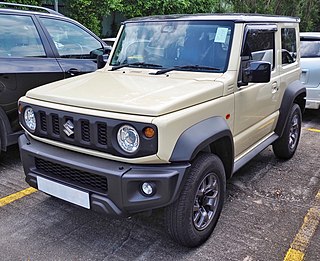
The Suzuki Jimny is a line of four-wheel drive off-road mini SUVs, manufactured and marketed by Japanese automaker Suzuki since April 1970, and now in its fourth generation.
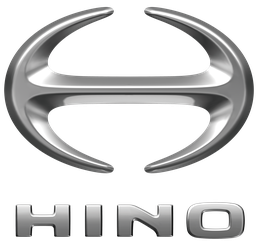
Hino Motors, Ltd., commonly known as simply Hino, is a Japanese manufacturer of commercial vehicles and diesel engines headquartered in Hino, Tokyo. The company is a leading producer of medium and heavy-duty diesel trucks in Asia.
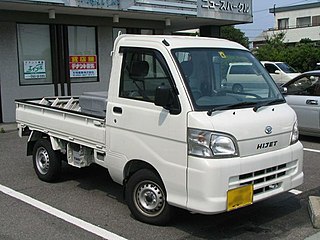
The Daihatsu Hijet is a cab over microvan and kei truck produced and sold by the Japanese automaker Daihatsu since 1960. Despite the similarities between the Hijet name and Toyota's naming scheme for its trucks and vans, the name "Hijet" has been in use for Daihatsu's Kei trucks and Microvans since 1960, over two decades before Toyota took control. "Hijet", when transliterated into Japanese, is very similar to "Midget", one of Daihatsu's other mini-trucks. According to Daihatsu, the name "Hijet" was created to imply that the vehicle offers higher performance than the Midget. The Hijet competes in Japan with the Honda Acty, Mitsubishi Minicab, Nissan Clipper, Subaru Sambar and Suzuki Carry.

The Volkswagen Taro 1 tonne pickup truck was introduced in January 1989 by Volkswagen Commercial Vehicles to complement the half tonne Caddy pickup / panel van ranges, and the 1 tonne Transporter van and chassis cab ranges. The name "tarō" is a suffix used in Japanese to denote the oldest brother or son, or the first-born son of a family.
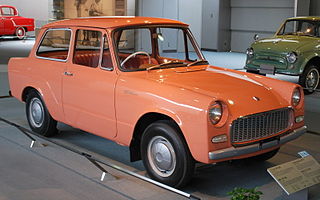
The Toyota Publica is a small car manufactured by the Japanese automaker Toyota from 1961 to 1978. Conceived as a family car to fulfill the requirements of the Japanese Government's "national car concept", it was the smallest Toyota car during that period and was superseded in that role by the Toyota Starlet, which itself started out as a version of the Publica. It was available as a 2-door vehicle only, but in a selection of body styles, ranging from the base sedan through a station wagon, convertible, coupé and even a coupe utility (pickup), which outlived the other models by a decade, and spawned other models, such as the Toyota Sports 800 and the Toyota MiniAce.
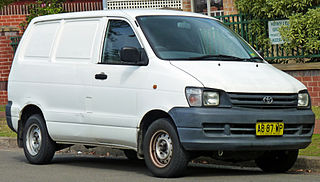
The Toyota LiteAce and TownAce are a line of light commercial and derivative passenger vans produced by the Japanese car manufacturer Toyota. These vehicles originally utilized the cab-over-engine configuration, although since 1996 a semi-cab-over arrangement has featured instead. The LiteAce launched in 1970 as light-duty truck, with commercial and van/wagon body variants added in 1971. In 1976, Toyota released the larger TownAce van/wagon that derived from the LiteAce; a TownAce truck arrived later in 1978. Between 1982 and 1992, the series accommodated the MasterAce Surf—an upscale TownAce passenger wagon.
The Prince Miler is a medium-sized pickup truck built by the Prince Motor Company. It remained on the market for four years after the 1966 merger, when Prince dealerships became integrated within Nissan's organization as Nissan Prince Store. By 1970, however, it was integrated with Nissan's newest generation of their offering in this class, the Junior.

Suzulight was the brand used for kei cars built by the Suzuki Motor Corporation from 1955 to 1969. They were Suzuki's first entry into automotive manufacturing, having previously only produced motorcycles. The Suzulight sedans and light vans all had transversely mounted engines and front-wheel drive. The Suzulight Carry trucks and vans were the first to use the Carry label, still around today.

The Toyota ToyoAce is a light to medium cab over truck built by Toyota since September 1954. Until a renaming contest in 1956, the truck was sold as the "Toyopet Light Truck SKB". Since 1985 the ToyoAce and Dyna truck lines have been merged, with the Dynas generally being intended for heavier duty work. In Japan, it was exclusive to Japanese Toyota dealerships called Toyopet Store.

The Nissan Junior was a series of medium-sized pickup trucks built from 1956 until 1982. It was introduced to fill the gap between the smaller, Datsun Bluebird based Datsun Truck, and heavier load capacity Nissans under the Nissan Diesel brand, like the 80-series trucks. After the merger with Prince Motor Company, the Junior and the Prince Miler were combined, sharing most of the characteristics, with the Junior sold at Nissan Bluebird Store Japanese dealerships, and the Miler sold at Nissan Prince Store until 1970.
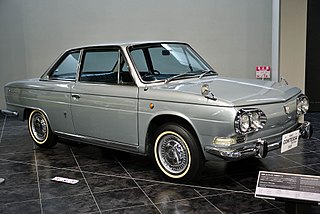
The Hino Contessa is an automobile which was produced by Hino Motors from 1961 to 1967.

The Toyopet Master, introduced in January 1955, is a passenger car that was an evolution of the earlier Toyota SF/RH sedan with a modernized body. As with its predecessor, the Master has a ladder frame truck chassis with leaf sprung solid axles both at the front and the rear. The more conservative Master was sold in parallel with the first Toyota Crown as a frugally equipped and robust version meant for taxi usage. The Master and Crown shared the same R-series engine, which produces 48 PS (35 kW) in the Master. It was sold at a chain of Toyota Japan dealerships called Toyota Store, next to the more upscale Crown, which was intended as a private purchase alternative to the Master.

In May 1950 the heavy-duty Hino TH10 truck was introduced, equipped with the all-new 7-liter DS10 diesel engine. An eight-tonner, this was considerably larger than existing Japanese trucks which had rarely been built for more than 6 tonnes (13,200 lb) payload. The model became a common sight in Japan and in Southeast Asia, its main export market, before being retired in 1968 in favor of the more modern cab over trucks which succeeded it. The Hino TE and derivatives was the first truck to be manufactured in Myanmar, where it was built until the turn of the millennium.
Tokyu Kurogane Industries, or Kurogane, was one of the first Japanese automakers. It built vehicles from about 1926 until 1962 when a subsidiary of Nissan, called Nissan Machinery, assumed operations as the company had become a member of the Nissan Group keiretsu. The word kurogane is an old term for iron, and one of the kanji used in Mr. Makita's first name. Remnants of the company were called Nissan Machinery until 1985, and operated as a separate entity within Nissan Techno (日産テクノ) until 2006, building and developing all of Nissan's current engines.
